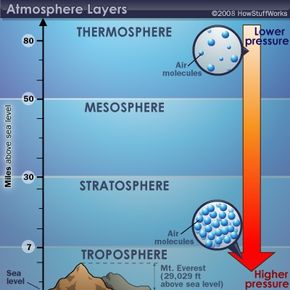Can You Feel the Heat? Solar and Terrestrial Radiation
The sun emits a vast amount of energy, which travels across space in the form of short-wave radiation. Only a tiny portion of this power actually reaches the surface. But most of the atmosphere isn't directly heated by solar radiation, but rather by the terrestrial radiation that the planet itself emits.
Ever see a video of someone frying an egg on the pavement on a hot day? It's the heat emitted by the pavement that's doing the frying, not the sun, despite the fact that the pavement was heated by the sun to begin with. Earth's surface absorbs solar radiation and emits terrestrial radiation.
Advertisement
Why does the air absorb this home-brewed radiation on the rebound instead of the fresh solar energy? Well, a solar-charged Earth emits long-wave radiation. While water vapor and carbon dioxide molecules merely allow the passage of incoming short waves, they absorb Earth's long waves, heating the atmosphere from the ground up. This is why a mountain climber will encounter increasingly colder conditions as he or she ascends, despite effectively moving closer to the sun.
Scientists divide the atmosphere into four layers based on temperature.
- Troposphere: With the exception of satellites and some aircraft, our entire world resides within this bottom layer. Even the tallest mountains don't scrape its upper boundary, called the tropopause, at roughly 7 miles (11 km) above sea level (the thickness of the troposphere varies with latitude and season). At this point, the steady drop in temperature that occurs as elevation increases stops. The troposphere contains all our weather and 80 percent of the planet's air mass. Remember, the lower the altitude, the higher the air pressure. Even though this layer isn't as thick as higher altitude layers, the molecules are more tightly packed.
- Stratosphere: This layer extends another 23 miles (37 km) into the sky, terminating 30 miles (48 km) above the planet's surface at the stratopause. If you ascended through the atmosphere, the steady decrease in temperature you experienced throughout the troposphere would halt at the tropopause and remain constant for the first 12 miles (20 km) of the stratosphere. At this point, the temperature would begin to climb again, thanks to the ozone, which absorbs ultraviolet radiation from the sun. The temperature would keep rising until you reached the stratopause.
- Mesosphere: Above the stratopause, the atmosphere's third layer begins to gradually get colder as you get closer to the mesopause, located more than 50 miles (80 km) above Earth's surface. The atmosphere's coldest temperatures occur here, dipping down as low as -130 degrees Fahrenheit (-90 degrees Celsius) [source: Tarbuck and Lutgens].
- Thermosphere: The final layer of the Earth's atmosphere extends from the mesopause up to the very edge of space. The air molecules in this low-density layer are literally few and far between. As the molecules have less mass, they absorb solar radiation much faster. Temperatures in the thermosphere can reach higher than 3,100 degrees Fahrenheit (1,700 degrees Celsius). It wouldn't feel as hot, however, due to the low density. Think of a 3,100-degree nitrogen molecule as a smelly dog. If you were surrounded by a dozen of them spread out over a football field, you'd hardly notice the stink. But pack yourself into a broom closet with them, and you'd soon be gasping for breath.
Now let's examine how the forces behind air temperature and air pressure affect the weather.
